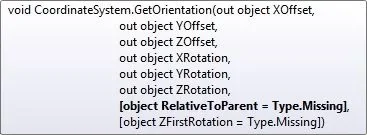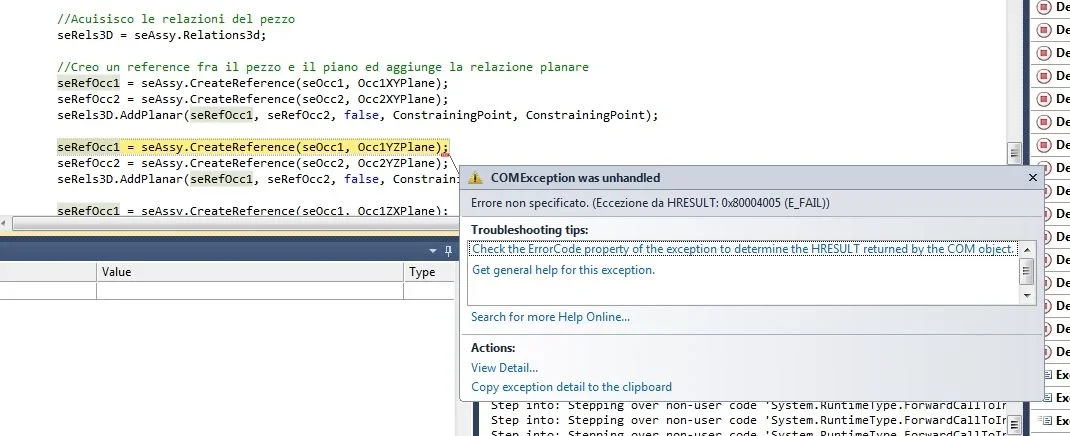Sbabba
Guest
Hello, everyone.
for the thesis I am working on an automatic assembly of a series of standard components in different configurations.
I wrote a c# program that allows the selection of these components and commands two cads, solid works and solid edge, for the assembly of the models of such components according to the chosen configuration.
regarding solid works I had no problem. I have inserted two floors between them orthogonal and one axis on the end of each piece, so that they can be coupled together through two commands of complanarity and one of coaxiality; this mating procedure is iterata for each pair of components until the final assembly is created, as the plans and axes always have the same name and sw selects plans and axes with a syntax of the type "name_piano@nome_parte@nome_assembly".
for precision the controls used are:
selectbyid2() for the selection of plans and axes with which to perform the coupling;
addmate3() for the addition of planar and axial coupling.
Now I'm trying to do the same thing with solid edge, but I have difficulties.
first I found the axialrelation3d() and planarrelation3d() commands to perform the matings, but I have a lot of doubts about how it can do. the sdk of st4 says (qui) that it is possible to use the command planarrelation3d() to make parallel two faces of two different parts: instead of two faces, would it be possible to use two floors created by me, named in a very precise way, so as to apply the same iterative command for the various components?
As far as coaxiality is concerned, it seems to me that it is not possible, because the axialrelation3d() command makes two axes of two cylindrical parts, but in my case I have not only cylindrical parts; Moreover if it does not allow, unlike sw, to insert axes to pleasure. I could easily solve the problem using a third floor and a third conspiracy, but I wanted to make sure of this.
Unfortunately online there are very little information regarding the use of solid edge bees with assembly, and the sdk of if is extremely scarce if compared to that of sw, then brancolo a little in the dark.
I thank in advance anyone who can give me even the smallest help!! and on the extremit
for the thesis I am working on an automatic assembly of a series of standard components in different configurations.
I wrote a c# program that allows the selection of these components and commands two cads, solid works and solid edge, for the assembly of the models of such components according to the chosen configuration.
regarding solid works I had no problem. I have inserted two floors between them orthogonal and one axis on the end of each piece, so that they can be coupled together through two commands of complanarity and one of coaxiality; this mating procedure is iterata for each pair of components until the final assembly is created, as the plans and axes always have the same name and sw selects plans and axes with a syntax of the type "name_piano@nome_parte@nome_assembly".
for precision the controls used are:
selectbyid2() for the selection of plans and axes with which to perform the coupling;
addmate3() for the addition of planar and axial coupling.
Now I'm trying to do the same thing with solid edge, but I have difficulties.
first I found the axialrelation3d() and planarrelation3d() commands to perform the matings, but I have a lot of doubts about how it can do. the sdk of st4 says (qui) that it is possible to use the command planarrelation3d() to make parallel two faces of two different parts: instead of two faces, would it be possible to use two floors created by me, named in a very precise way, so as to apply the same iterative command for the various components?
As far as coaxiality is concerned, it seems to me that it is not possible, because the axialrelation3d() command makes two axes of two cylindrical parts, but in my case I have not only cylindrical parts; Moreover if it does not allow, unlike sw, to insert axes to pleasure. I could easily solve the problem using a third floor and a third conspiracy, but I wanted to make sure of this.
Unfortunately online there are very little information regarding the use of solid edge bees with assembly, and the sdk of if is extremely scarce if compared to that of sw, then brancolo a little in the dark.
I thank in advance anyone who can give me even the smallest help!! and on the extremit


